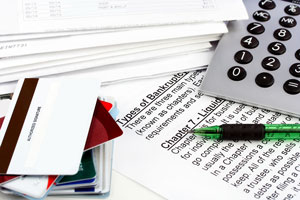Types of Bankruptcy

At your consultation with Don Adler, you will talk about the Means Test. The Means Test usually determines the type of bankruptcy you file. If your household income in the six months before you file your bankruptcy case was less than the median average income in your state, Massachusetts or New Hampshire, you qualify to file a Chapter 7 case under the Means Test. Even if your income was greater than the median income you may still qualify. High income earners can pass the Means Test. This analysis can be complicated.
You need to work with an experienced bankruptcy lawyer to calculate your average monthly income and allowable expenses. We find that many of our clients whose income is greater than the state median income are still eligible to file for Chapter 7 bankruptcy.
Upon filing a bankruptcy case the automatic stay goes into effect and immediately stops creditors from taking any action against you or your property to collect a debt. The automatic stay is a powerful weapon that all debtors have and is one of the primary reasons bankruptcy cases are filed.
In the majority of Chapter 7 cases with consumer debt, the debtor will keep most if not all of his or her property and wipe out most if not all
unsecured debts. Income taxes may also be eliminated. A benefit that is often overlooked is that you may be able to rebuild your credit faster after filing a Chapter 7 case than if you allow debt to accumulate and remain unpaid.
If you do not qualify for Chapter 7, you may file a bankruptcy case under Chapters 13, 11 or 12. Doing so may give you more flexibility to keep your property and pay off your debts and taxes then under Chapter 7.
Chapter 13 is often used to prevent foreclosures, repossessions, levies or seizures of business assets. It allows you to catch up on your overdue mortgage and car payments, business debt and back taxes over 3 to 5 years, often at a small percentage of what you owe your unsecured creditors. Or, when you have property you want to keep that is not exempt, you may be able to do so under a Chapter 13 plan.
Under Chapter 13 you may be able to eliminate a second mortgage and other junior liens on your home or other real estate or business assets. In addition, you may eliminate certain debts that you cannot discharge in a Chapter 7 case. This is called the Chapter 13 "Super Discharge".
Individuals who operate small businesses as sole proprietorships may turn to chapter 13 to successfully reorganize their businesses' financial affairs. You may be able to restructure the terms of loans, leases and payments on past-due income and business taxes.
Individuals may file under Chapter 11 where they do not meet the requirements for filing under Chapter 7, Chapter 12, or Chapter 13. Small businesses that are incorporated or an LLC, may also file under Chapter 11. Chapter 11 is usually filed by a business to reorganize its debts, retain its assets, and continue to operate. As in Chapters 13 and 12, the debtor remains in possession of its assets and pays its creditors under a reorganization plan. Since Chapter 11 was written primarily to help businesses reorganize, the procedures are more complex and time consuming and the process usually more costly than reorganizing under either Chapter 13 or 12.
Chapter 12 is known as the most debtor-friendly proceeding in the Bankruptcy Code. It allows eligible farmers and commercial fishermen to reorganize their business and keep their livestock, crops, equipment, or fishing boats, by paying their creditors out of future income over a period of years.

 Chapter 7
Chapter 7